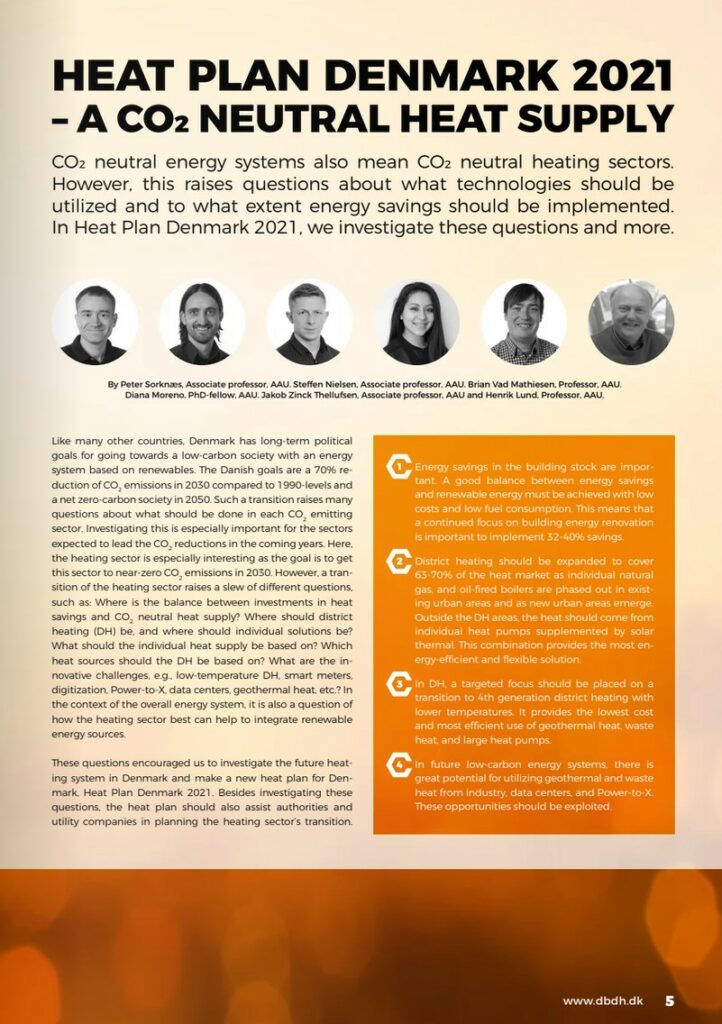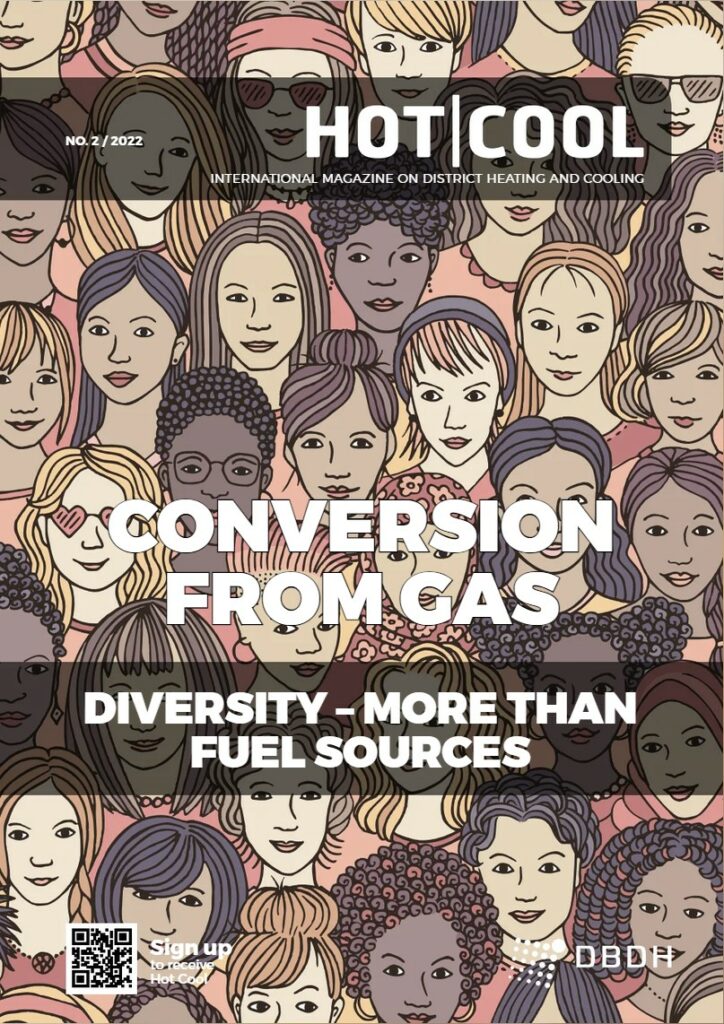CO2 neutral energy systems also mean CO2 neutral heating sectors. However, this raises questions about what technologies should be utilized and to what extent energy savings should be implemented. In Heat Plan Denmark 2021, we investigate these questions and more.
Like many other countries, Denmark has long-term political goals for going toward a low-carbon society with an energy system based on renewables. The Danish goals are a 70% reduction of CO emissions in 2030 compared to 1990-levels and a net zero-carbon society in 2050. Such a transition raises many questions about what should be done in each CO emitting sector. Investigating this is especially important for the sectors expected to lead the CO reductions in the coming years. Here, the heating sector is especially interesting as the goal is to get this sector to near-zero CO emissions in 2030.
However, a transition in the heating sector raises a slew of different questions, such as: Where is the balance between investments in heat savings and CO neutral heat supply? Where should district heating (DH) be, and where should individual solutions be? What should the individual heat supply be based on? Which heat sources should the DH be based on? What are the innovative challenges, e.g., low-temperature DH, smart meters, digitization, Power-to-X, data centers, geothermal heat, etc.? In the context of the overall energy system, it is also a question of how the heating sector best can help to integrate renewable energy sources.
These questions encouraged us to investigate the future heating system in Denmark and make a new heat plan for Denmark, Heat Plan Denmark 2021. Besides investigating these questions, the heat plan should also assist authorities and utility companies in planning the heating sector’s transition.
Mapping the heating demand and supply
In Heat Plan Denmark 2021, we both map the geography of the heating demand and supply, as well as relate these to the integration potential in the Danish energy system. The mapping involves seven different detailed geographical information system analyses covering all of Denmark. These include estimates for annual heat demands and energy saving potentials of all Danish buildings and costs and heat loss of DH grids in about 3,000 areas, which currently are without DH. These mapping data provided input for making over 1,000 hour-by-hour energy system simulations for a future Danish decarbonized energy system.
Heat savings in the building stock
In Heat Plan Denmark 2021, heat-saving options are estimated for each building in Denmark. This is done based on the Danish heat atlas, a detailed GIS mapping of estimated annual heat demands in nearly 2 million Danish buildings1. The estimates for each building’s demand are based on a heat consumption model that uses average heating needs based on the buildings’ use, age, and size. The heat consumption model is linked to the building-specific data from the national Building and Housing Register. The main principle behind heat savings in buildings is that they should only be implemented until the cost of decarbonizing the heat supply is cheaper than the cost of increased heat savings.
The importance of heat savings
In Heat Plan Denmark 2021, we find that heat savings should be done regardless of whether DH is expanded or not. The reason is that heat savings are important for reducing costs in the energy system and keeping biomass consumption at a sustainable level. The results show that the costs in the energy system are lowest, with heat savings between 32% and 36% in the building stock. These are flat optimums, and a sensitivity analysis shows that increasing heat savings to 40% can result in further reductions in biomass consumption with only a marginal increase in the energy system’s cost. The heat savings can include improvements of the buildings’ climate screen (exterior walls, roofs, etc.) and a more optimized operation of the heating systems through, e.g., intelligent meters and control equipment.
Five scenarios for DH expansion
District heating should be expanded In Heat Plan Denmark 2021, we also analyze where DH should be utilized. We do this by using the estimates for heat demands for all buildings in Denmark and finding the heat density for each area without DH. We then make five scenarios for DH expansion. Specifically, in Heat Plan Denmark 2021, we analyze the following expansion scenarios:
- Buildings currently registered with DH (~ 50%)
- All buildings in areas designated for DH (~ 59%)
- Extensions to urban areas with heat density above 15 kWh/m2 (~ 63%)
- Extensions to urban areas with heat density above 10 kWh/m2 (~ 70%)
- Extensions to urban areas with heat density above 5 kWh/m2 (~ 74%)
More than 3,000 areas without DH are evaluated, and for each area, a DH grid layout is modelled, including pipe sizes, costs, and grid losses.
The five expansion scenarios have been simulated in a national energy system analysis tool, simulating the entire energy system hour-by-hour. This is done to identify how the different expansion levels affect a future Danish energy system based on 100% renewable energy sources.
We find that expanding DH from the current approx. 50% of the total heat demand in buildings to 63-70% will most benefit the energy system. The expansion is primarily at the expense of individual heating with natural gas, but also oil, biomass, and direct electric heating. In Heating Plan Denmark 2021, we propose an expansion to 70% as the main suggested expansion. 70% provides the lowest costs in the energy system while reducing the pressure on the need for biomass and wind power in the overall energy system The spread between 63-70% is due to uncertainties in the national model. Local conditions, such as the placement of new buildings, can affect the most appropriate level of district heating in each area.
Transition to 4th generation district heating
Though it is relevant to expand the DH system in Denmark, it is also essential that existing DH systems transition from the current temperature levels of around 80°C in the supply and 40°C in the return, corresponding to 3rd generation DH temperature levels, to 55-60°C in the supply and 25-30°C in the return, corresponding to the 4th generation DH temperature levels. Such a transition must take place in conjunction with an ongoing energy renovation of the building stock.
The analyzes show that reduced temperature levels in the DH system provide increased synergies for the end-user and throughout the supply chain for DH. The transition to lower temperatures reduces the grid loss in the DH pipes, making a more efficient supply. However, the crucial advantage is that it ensures a much more efficient utilization of current and future DH sources. These are mainly waste heat, geothermal, heat pumps, and solar thermal.
Utilizing geothermal and waste heat
Utilizing waste heat and geothermal heat allows for low fuel consumption in DH. Waste heat has previously been from electricity production and industrial processes. However, new waste heat potentials are likely to be relevant in the future, such as waste heat from Power-to-X facilities. In Heat Plan Denmark 2021, we estimate the possibilities for waste heat, partly using GIS analyses, for industrial waste heat and geothermal heat, and partly via own and others’ estimates for the development of Power-to-X and data centers.
We find that in 2045 the total potential for waste heat and geothermal heat is between 12 and 42 TWh/year. This is on top of the amount of industrial waste heat currently utilized in Denmark, less than 1 TWh/year. The high potential can theoretically cover the entire current need for DH. In a future system, the DH demand depends partly on the DH coverage and the energy consumption of the building mass. In the main Heat Plan Denmark 2021 scenario, DH has been expanded, and the building stock has been made more energy-efficient, resulting in the DH demand being at the same level as today.
To accelerate the green transition, DH should be significantly expanded already before 2030. In 2045, it is estimated that waste heat from industries, data centers, and Power-to-X and geothermal energy will cover half of the DH production, corresponding to 19 TWh/year.
While the Heat Plan Denmark 2021 focuses on Denmark and Danish conditions, it can be seen as a good indicator for the role of energy efficiency in the building sector and the role of DH in achieving the goal of decarbonization of the energy supply in Europe. Previously we have constructed analyses for Europe in the Heat Roadmap Europe projects2.
Access to European maps and reports: www.heatroadmap.eu


